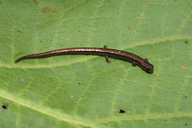|
Description
This is a tiny species; adult standard length averages 17.9 mm in 12 males (range 15.5-19.3) and 18.5 mm in 10 females (range 16.9-21.4). The head is relatively broad; SL averages 7.0 times head width in males (range 6.2-7.4) and 7.1 times head width in females (range 6.5-7.7). Snouts are short and pointed. Nostrils are round to slightly oval; the mean ratio of major axis to minor axis is 1.06 in males (range 1.00-1.11) and 1.03 in females (range 1.00-1.11). Nostrils are relatively small in both sexes, but slightly larger in males (mean length of major axis 0.41 mm) than in females (0.39 mm), despite the males' smaller average body size. The eyes, though small, are prominent and extend beyond the margin of the head in ventral view. A suborbital groove intersects the lip on each side of the head. There are 1-2 premaxillary teeth in males (mean 1.2) and 2-4 teeth in females (mean 2.8). Vomerine teeth average 6.4 in males (range 5-8) and 6.2 in females (range 6-7). There are no maxillary teeth. Limbs are relatively long; limb interval averages 4.3 in males (range 3-5.5) and 4.6 in females (range 3.5-5.5). Hands and feet are narrow; digits are short and the longest ones are pointed. The tail is relatively long, typically much longer than standard length; mean SL divided by tail length equals 0.83 in males (range 0.60-1.08) and 0.80 in females (range 0.70-0.96). The parotoid gland is discrete, but the mental gland is indistinct, even in large adult males. In terms of external characters, this is among the least sexually dimorphic of any species in the genus.
Coloration in life, based on field notes by J. Hanken for MVZ 186902: There is a brownish dorsal stripe with a fine, black-and-brown herringbone pattern. The venter is dark with fine white flecking
Distribution and Habitat
Country distribution from AmphibiaWeb's database: Mexico
Thorius pennatulus is known from a number of forest localities in lowland Veracruz, Mexico. Elevations range from about 1000 m between Orizaba and Cordoba, to almost 2000 m near Soledad Atzompa (KU 154630-33). It is an exclusively terrestrial species; according to field notes by D. Wake (3 Apr. 1970) and J. Hanken (31 Jan. 1976), specimens in Cuautlapan were found under rocks, inside and under rotting logs, and among the leaf litter at the base of banana trees. Northernmost samples are from the vicinity of Teocelo (ca. 1000 m), which is ca. 15 km south of Jalapa and near, but much lower in elevation than, the type locality of T. minydemus. (These samples are the basis for including T. pennatulus in the Veracruz transect of Wake et al. [1992]). We assign specimens from Teocelo to T. pennatulus based on their general morphological similarity to specimens from more southerly localities. Dunn (1926:375) referred montane populations of Thorius from widely scattered localities in Oaxaca (Cerro San Felipe) and Veracruz (Xometla) to T. pennatulus, but these populations belong to different species.
References
Dunn, E. R. (1926). The Salamanders of the Family Plethodontidae. Smith College, Northhampton, Massachusetts.
Hanken, J. and Wake, D. B. (1998). ''Biology of the tiny animals: Systematics of the minute salamanders (Thorius: Plethodontidae) from Veracruz and Puebla, Mexico, with descriptions of five new species.'' Copeia, 1998(2), 312-345.
Wake, D.B., Papenfuss, T.J., and Lynch, J.F. (1992). ''Distribution of salamanders along elevational transects in Mexico and Guatemala.'' Tulane Studies in Zoology and Botany, Supplementary Publication, 1, 303-319.
Originally submitted by: David B. Wake (first posted 2000-11-08)
Edited by: M. J. Mahoney (2008-01-13)Species Account Citation: AmphibiaWeb 2008 Thorius pennatulus <https://amphibiaweb.org/species/4211> University of California, Berkeley, CA, USA. Accessed May 29, 2025.
Feedback or comments about this page.
Citation: AmphibiaWeb. 2025. <https://amphibiaweb.org> University of California, Berkeley, CA, USA. Accessed 29 May 2025.
AmphibiaWeb's policy on data use.
|





 Raffaëlli Account
Raffaëlli Account Map of Life
Map of Life